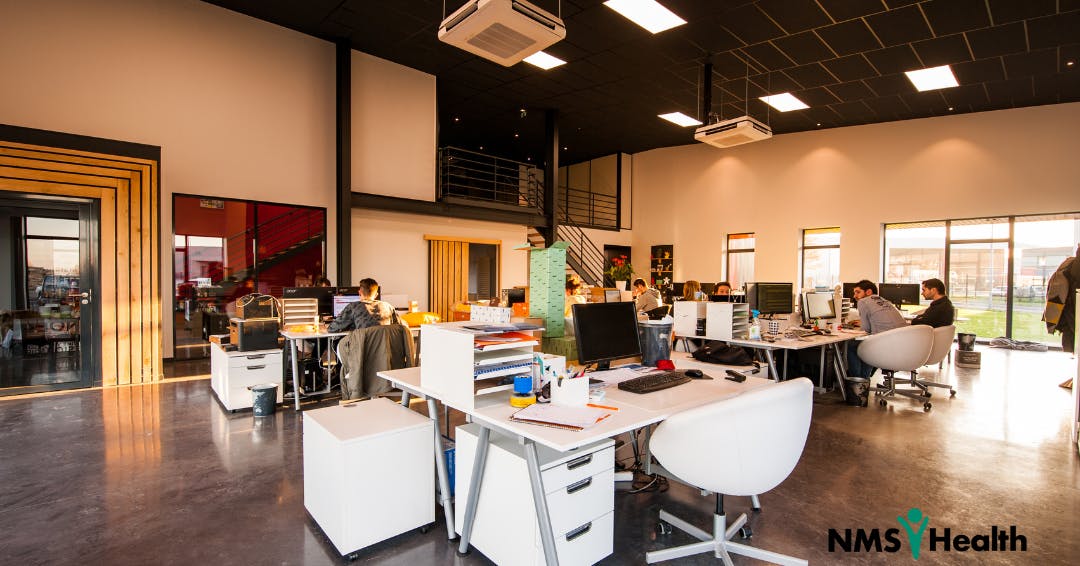When they think of safety hazards at work, many people picture worksites with heavy machinery, manufacturing floors, and employees engaging in demanding manual tasks under laborious circumstances. This is not quite the case. While construction industries, and agriculture, forestry, fishing, and hunting experienced the highest death rates in 2020, the education and health services industries saw a marked increase in injury and illness rates. While the COVID-19 pandemic obviously impacted the number of illness cases, COVID-19 is not the only danger lurking in the office.
Falls
Slips, trips, and falls at work are incredibly common. According to the National Safety Council, in 2020 alone, more than 211,000 workers suffered injuries that required days off from work. Marble and tile floors can be extremely hazardous and slippery, especially in areas where water is present such as kitchens, break rooms and bathrooms. Placing carpet, mats, or other slip-resistant materials can reduce falls, especially in areas such as entranceways.
It is also important to keep office walkways free from clutter and maintain a clear line on vision. Boxes, files, and office supplies should be stored in a specific location away from high traffic areas. Items such as electrical cords should not be outstretched or ran across walkways as they are a tripping hazard, as well as a fire hazard.
Fire Safety
Offices, unfortunately, are a hot bed for fire hazards with cooking equipment, electrical cords and space heaters being some of the biggest culprits. According to the National Fire Protection Association (NFPA), during the five-year period between 2007 and 2011, the NFPA estimated that U.S. fire departments responded to an average of 3,340 fires in office properties per year.
Electrical cords and space heaters should be inspected regularly to ensure that they are in safe, working condition. Cords should be removed and replaced if they are frayed, have exposed wire or if the third prong has been damaged or removed. Extension cords should not be overloaded, used improperly, or used if there is any damage to the cord. Extension cords should also not be used to power a space heater. Space heaters should be plugged into an outlet directly and have a switch that automatically shuts off the heater if the heater is tipped over. Additionally, space heaters should be placed in an open space and away from any combustible materials such as paper.
Ergonomic injuries
Because many employees may be spending much of their workday sitting at desk, repetitive movement and posture injuries are common. Providing adjustable equipment, and equipment suited for the individual employee, is an important component of workplace safety. Items such as adjustable chairs, monitor stands, and desks should be made available to accommodate as many employees as possible. If an employee requests a specific ergonomic item, accommodations should be considered. While these items may be somewhat costly, it could be a wise investment that prevents future costs due to absenteeism, loss of work productivity, and workers compensation claims.
Vision strain
An estimated 70% of adults experience digital eye strain – eye and vision problems that result from prolonged computer, and screen use. Employees can experience blurry vision, headaches, sensitivity to light, and neck and shoulder pain when spending too much time in front of a screen. First and foremost, employees should give their eyes a rest. OSHA recommends taking a 20-second break to view something 20 feet away every 20 minutes in addition to taking a short break from computer tasks every hour. During screen time, computer monitors should sit slightly below eye level, and 20 to 26 inches away from the eyes to minimize strain.
The florescent lighting that is a hallmark of typical office spaces also contributes to eye strain. Florescent lights are often too bright and can cause eye fatigue. By removing some bulbs from the fixtures, and encouraging employees to use task lamps if needed, employees’ eyes get a welcome break. This also helps to reduce the amount of screen glare on the computer monitors which contributes to eye fatigue as well.
Tackling these and other common office hazards doesn’t have to be complicated, but it does take awareness and a dedication to the safety and health of your employees. By implementing these small changes, establishing routines, and educating employees about hazards and how to avoid them the office won’t seem like such a scary place.
Sources
National Fire Protection Association. (n.d.). U.S. structure fires in office properties. NFPA. Retrieved July 19, 2022, from https://www.nfpa.org/News-and-Research/Data-research-and-tools/Building-and-Life-Safety/US-Structure-in-Office-Properties
National Safety Council. (2022, January 5). Most dangerous industries. Injury Facts. Retrieved July 19, 2022, from https://injuryfacts.nsc.org/work/industry-incidence-rates/most-dangerous-industries/
OSHA. (n.d.). United States Department of Labor. eTools : Computer Workstations - Additional Information | Occupational Safety and Health Administration. Retrieved July 19, 2022, from https://www.osha.gov/etools/computer-workstations/additional-information


